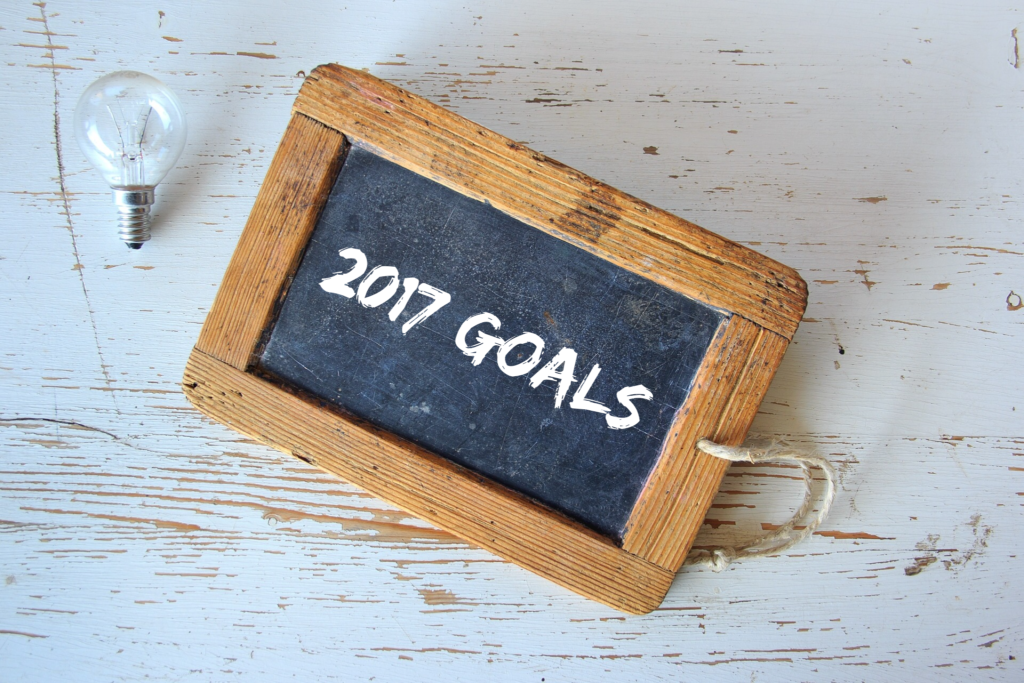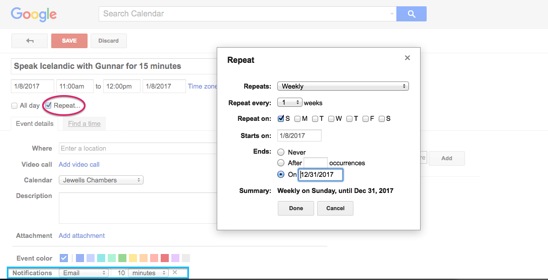

I know we are almost three weeks into 2017 but hooray for a new year!!! Whether you made resolutions or not, now is a great time to reflect on your fluency progress in 2016 and see what you can improve or change in order to reach your language learning goals this year. There are no set rules for learning a language but I think these top 5 tips for success in 2017 can be applied to any method of learning that you are currently using. Read. Apply. Repeat! 🙂
1. Write Down Your Language Learning Goals and have a Deadline
This is a super simple step that many people overlook because they, including myself, assume that the goals in our head are good enough. However, it is powerful to write out what you want and doing so can improve your odds of achieving said goals. It is important to keep in mind that your goals need to be specific and must have a deadline. There is nothing wrong with having an overarching language learning goal that you want to achieve. The only issue is that many people only have that goal and neglect to break it down into smaller steps, or micro goals, that can be completed along the way. Finishing small feats can turn into big progress, and that is great for keeping yourself motivated.
Example of a vague goal: I want to be fluent in Spanish by the end of the year.
While fluency in a language might be your ultimate goal, it is difficult to track the progress of your journey if you are not more specific about what you want to accomplish and when. Below I have better defined the overall goal and I provided two examples of smaller language learning goals that will help you achieve it.
More specific overall goal: I want to be able to read and understand an entire newspaper written in Spanish without needing to translate any words by December 31st, 2017
Micro goals:
- Learn one new Spanish word every day
- This is a super simple task that must be completed every 24 hours, and is great for a beginner or intermediate language learner. It might seem small but over time you will amass many words. The amount of words you learn daily is totally up to you, but I think that keeping the goals super simple means that they are not only easy to achieve but they are also easy to exceed. Tim Ferriss’ video on Goal Setting: Rig the Game So You Can WIn It is what inspired me to create very simple tasks that are easy to complete. I use programs, like Memrise, to track the amount of words I have learned for Icelandic. I find that the amount of words I learn daily changes but I can easily achieve learning at least one, new word every day.
- Read at least one new article written in Spanish 3 times a week and learn the words that I don’t know in the article
- This micro goal works directly on your overall goal but now you have tasks each week to complete in order to achieve it. Over the course of a year, if you stick to the schedule, you would have read 156 articles written in Spanish, and you would have learned many new words that are found in newspapers.
Whether you create micro goals like the ones I mentioned above or make your own, it is important that you write them down and act on them. I suggest starting with five micro goals and reassessing after two months if you want to alter them in any way. Remember that simple is best.
2. Create a Language Learning Schedule and Stick to it!
I know that organizing and scheduling strikes fear into the hearts of many because it seems like an arduous task, but I assure you that it can be a quick and painless process. By using a free schedule management program, like Google Calendar, you can set up months of language learning in 5 to 10 minutes. The repeat function on the calendar is so useful because I can schedule a micro goal like, Speak with Gunnar for at least 15 minutes in Icelandic, each week for the rest of the year in less than a minute! I also set up an alert so I am reminded 10 minutes before I am supposed to start my task.
After setting up your calendar, the next step is to stick to it. I know it is easier said than done and I have struggled at times with sticking to my schedule. However, if I find myself missing at least two scheduled learning times during the week, then I know that I need to reassess my schedule or my attitude. Some weeks will be busier than others ,so it is essential that you are realistic with your scheduling. If you are just starting out, I suggest setting aside small blocks of time each week that you dedicate to studying your language and increase the time as you get accustomed to the new schedule.
In regards to attitude, if it feels like a chore to do the task then maybe it is time to change the task or reassess why you are learning the language in the first place. Think of what motivated you to set out on this journey and use that to re energize your efforts.
Consistency is the key to success when it comes to reaching your language learning goals. Every day won’t be super exciting but enjoying the process and seeing your progress will make it easier to stick with it.
3. Have An Accountability Buddy
It is one thing to mention to someone that you want to complete a specific language learning goal, but it is a different story when you choose someone to keep you accountable for completing that task. An accountability buddy is a person that will check in with you to see how your progress toward your goals is coming along. It helps if the person is knowledgeable about the topic or has gone through a similar process, but mainly you need a person that will check in with you to see if you are making headway.
Whether they are celebrating when you reach a milestone or they are talking through why you have stalled in a particular area, it is really powerful to know that you have someone that is in your corner and is holding you accountable. It is best to share your micro goals with them and schedule regular check in times. You can check in every couple of weeks or every month but I recommend not going longer than a month between check in times. Regular assessments of your progress give you the power to change something if it is not working or to challenge yourself by increasing your efforts.
4. Find a Speaking Partner(s)
Speaking in a new language can feel like a daunting task and, as I mentioned in my “Is that Me Talking” post, it might seem really strange to hear these new sounds coming out of your mouth. However, if one of your language learning goals is to be able to speak fluently in your target language, then you have to practice it. I still struggle with speaking at times because I think way too much before I speak, but a little bit of practice has been building up my confidence and is familiarizing my brain with thinking in Icelandic.
When choosing a speaking partner, it is absolutely necessary to pair up with someone that is fluent in the language you are learning. Because learning to speak a new language can be a very challenging and frustrating process for anyone, I recommend having a speaking partner that is patient and committed to speaking with you on a regular basis. You might find that you like having more than one speaking partner. Do whatever works best for you. This person can be your speaking partner and accountability buddy, but I like having different people for each role.
Here is a micro goal example that you can use for scheduling time with your speaking partner.
- Speak only Spanish for 15 minutes each week with a speaking partner
- Setting a specific amount of time each week that you have to speak in the language you are learning forces you to train your brain to think in it and work on listening comprehension. Plus, you get a chance to use some or all of the new words that you have been learning each day.
5. Have Fun!
Learning a new language can be a ton of fun, especially if you find activities that you already enjoy now and you integrate the language you are learning into them. Below is a short list of some activities that I do in Icelandic that keep me entertained and motivated to reach my language learning goals.
- Watch movies
- Listen to music
- Read books
- Workout classes
- Talk to my life partner
- Cook new recipes
The Internet has made so many resources available that a quick search can get you access to language learning materials that entertain and educate. Feel free to be as creative as you want when it comes to learning. Remember, it is your journey so personalize it to fit your individual needs and wants.
I hope my top 5 tips help you smash your language learning goals in 2017 and beyond. Check out my language learning resource page for websites and tools that I have found to be really helpful for learning Icelandic. Also, I would love to hear any tips or resources you are using to smash your language learning goals, so feel free to let me know about them in the comment section.
Þakka þér fyrir að lesa og sjáumst fljótlega! (Thank you for reading and see you soon!)


